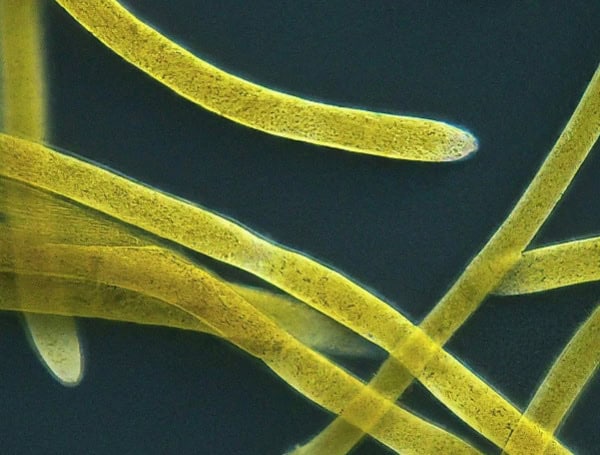POLK COUNTY, Fla. – The Florida Department of Health in Polk County (DOH-Polk) issued an alert today, April 21, 2025, cautioning residents and visitors about the presence of blue-green algae in several local water bodies.
The algae have been observed in Lake Crago by the boat ramp, Lake Van near the end of Lake Van Road, and Lake Hancock – South Central.
Currently, water sample testing is underway to determine if toxins are present. However, DOH-Polk emphasizes that blue-green algae have the potential to produce harmful toxins, and environmental conditions can change rapidly.
READ: Polk County Parking Spot Spat Leads To Arrest Of Davenport Woman
Therefore, it is crucial to take precautions even before toxin confirmation.
The health department strongly advises the public to avoid any contact with waters where a visible bloom is present. This includes:
- Do not drink, swim, wade, or use personal watercrafts in affected areas.
- Wash skin and clothing thoroughly with soap and water if any contact occurs with algae or discolored water that has an unpleasant odor.
- Keep pets and livestock away from the water. Waters with algae blooms are unsafe for animals, and they should be provided with an alternative water source.
- Do not use contaminated water for cooking or cleaning dishes. Boiling the water will not eliminate potential toxins.
While it is safe to eat fillets from healthy fish caught in freshwater lakes experiencing blooms, it is important to rinse the fillets with tap or bottled water, discard the guts, and cook the fish thoroughly. Residents are also advised not to eat shellfish from waters with algae blooms.
READ: Polk County Sheriff Seeks Public’s Help To ID Suspect In Four Corners Tire Slashing
The Florida Department of Environmental Protection (DEP) and its partners are actively monitoring the situation, collecting algae samples from the reported locations. Once the laboratory analysis is complete, toxin results will be available on the Protecting Florida Together website and DEP’s Algal Bloom Dashboard.
Understanding Blue-Green Algae
Blue-green algae are a common type of bacteria found in Florida’s freshwater environments. Blooms occur when there is a rapid growth of these algae, leading to a visible accumulation of cells that can discolor the water and often form floating mats with unpleasant smells. These blooms can also appear as scum, foam, or paint-like streaks on the water’s surface in various colors.
Several environmental factors can contribute to the development of blue-green algae blooms, including sunny days, warm water temperatures, stagnant water conditions, and an excess of nutrients. While blooms can occur throughout the year, they are more common during the summer and fall months. It’s important to note that blue-green algae may be present in the water even if a visible bloom is not apparent.
READ: Moo-ve Over, Methane: University Of Florida Scientists Find Promising Feed To Cut Cow Emissions
Potential Harm and Where to Find Information
Blue-green algae can produce toxins that pose a risk to humans, pets, and the ecosystem, including fish and other aquatic life. Sensitive individuals, such as children, the elderly, and those with compromised immune systems, may be at risk even at low concentrations and should avoid any exposure.
For more detailed information on the potential health effects of algae blooms, residents can visit the Florida Department of Health’s harmful algae blooms webpage.
Stay Informed and Report Issues
Up-to-date information on Florida’s water quality status, including public health notifications for harmful algae blooms and beach conditions, is available on the Protecting Florida Together website. Residents can also subscribe to receive notifications about water quality changes in their area.
To report issues related to algae blooms:
- Algae Blooms: Report blooms to the DEP online or by calling their toll-free hotline at 1-855-305-3903.
- Human Health: Report any symptoms of exposure to a harmful algae bloom or aquatic toxin to the Florida Poison Information Center at 800-222-1222.
- Animal Health: Contact a veterinarian if a pet becomes ill after contact with potentially contaminated water.
- Fish Kills: Report any dead, diseased, or abnormally behaving fish or wildlife to the Florida Fish and Wildlife Conservation Commission online or at 800-636-0511.
Residents with further health questions or concerns about blue-green algae are encouraged to contact DOH-Polk directly at 863-578-2024. The health department will continue to monitor the situation and provide updates as more information becomes available.
Please make a small donation to the Tampa Free Press to help sustain independent journalism. Your contribution enables us to continue delivering high-quality, local, and national news coverage.
Connect with us: Follow the Tampa Free Press on Facebook and Twitter for breaking news and updates.
Sign up: Subscribe to our free newsletter for a curated selection of top stories delivered straight to your inbox.
